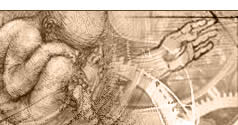 |
 |
 |
 |
 |
 |
 |
 |
|
 |
 |
 |
35 Polymer Chemistry
|
| Menu | back |
Today it is possible for chemists to produce amino acids with technical help. However, the formation of long chains such as required for living creatures is possible only under extremely clean conditions. Even minute impurities can lead to interruption of the chain. Moreover, the amino acid chains decompose as soon as they encounter water. Since such a hypothetic primordial soup would certainly have contained water, so it is impossible for such amino acid chains and particularly complete proteins to have formed.
A major problem for the origin of life is the fact that proteins decompose because of chemical laws as soon as they come into contact with water (1) (2). To make matters worse, water is produced during the production of the proteins. This process, called hydrolysis, disrupts polycondensation and immediately destroys any polymers developing. In living cells, a finely balanced process drains the water produced during protein production by special enzymes.
Chain formation with bifunctional molecules:
Molecules must be at least bifunctional in order to join (i.e., they must have two linkage points.) If a monofunctional molecule (i.e., a molecule with only one linkage point) attaches itself to the end of the chain, it is not possible for any further molecules to dock on, so chain formation is discontinued (3). Now, it is necessary to imagine that a primordial soup is not a polymer chemical laboratory where the various processes are supervised and the formation of chains is terminated specifically by adding monofunctional molecules only when the desired chain length has been reached (4).
The only environment known in which DNA strings form are the living cells. The prerequisite for creation of proteins is living cells which, for their part, also consist of proteins.
Without proteins there are no cells and without cells no proteins. Vivum ex vivo Life comes from life only. This principle is again confirmed.
These 36 | Menu |
back
|
References:
|
| (1) |
J. Sarfati, Origin of life: the polymerization problem, Journal of Creation 12(3), 1998, pages 281284. |
| (2) |
G.B. Johnson und P.H. Raven, Biology, Principles & Explorations, Holt, Reinhart and Winston, Florida, 1998, page 235. |
| (3) |
Bruno Vollmert, Das Molekül und das Leben, Rowohlt, 1985, pages 54-58. |
| (4) |
P.H. Raven, Biology, A current bubble hypothesis, WCB/McGraw-Hill, 1999, page 69. | |
| |
Comment this Site!
|
 |
 |
 |
 |
|

